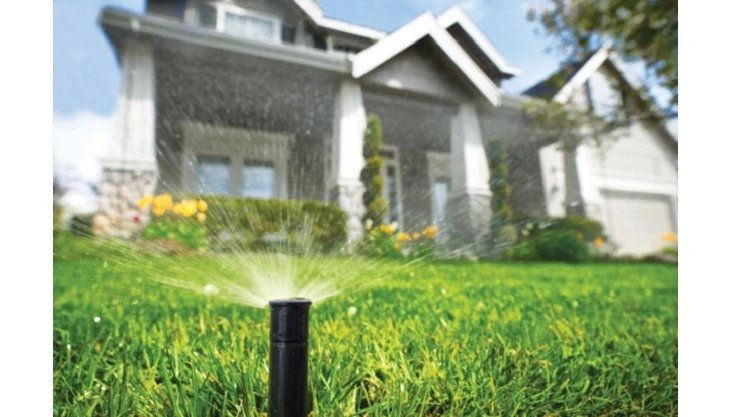

Where the water goes is one of the most important, if not the most important, job of an irrigation system. So, we checked in with some manufacturers to get some updates on products and advice about spray heads and nozzles.
Shane Gray, associate product manager, Hunter
Q: What advancements have your nozzles and spray heads had over the past five years?
A: Pressure regulation is the first step in ensuring spray nozzles perform as expected. Too much pressure can lead to misting, runoff and high flows while putting added stress on the body and nozzle. The Pro-Spray PRS30 pairs with spray nozzles by providing 30 PSI to the nozzle.
All Pro-Spray models come with a co-molded wiper seal that reduces flow-by and prevents debris from entering the seal when the riser retracts. This ensures spray bodies fully retract every time and prevents debris infiltration, which can cause damage and clogs.
A recent feature added to the pressure-regulated Pro-Spray is FloGuard technology. If a nozzle goes missing, FloGuard reduces the flow of the spray head – from up to 30 GPM to 0.5 GPM while generating a 10-foot indicator stream. This eliminates water waste and signals the need for maintenance. The stream has such a low flow rate that it allows the rest of the zone to remain operational.
“Explain to your customers why a professional should perform winterization on the system.” Shane Gray, associate product manager, Hunter
Q: What advice do you have for contractors on winterizing heads and nozzles?
A: Know the products that are in the ground. If you have heads with check valves in them, you should ensure they are not retaining water after you drain or blow out the system. When using a Hunter spray body with a check valve, simply lift on the riser and the check valve will release. This allows any excess water to drain out.
Next, be aware of your weak points. Never exceed the pressure rating of the component with the lowest pressure rating in the system. This is an easy step to forget and any damage that occurs may not be noticed until the system is turned back on in the spring.
Explain to your customers why a professional should perform winterization on the system. The most common comment from customers is that they can just do it themselves with their pancake compressor because it goes to 150 PSI. You then mention CFM and they have no idea what you mean. Help your customers understand these things so you can justify the sale.
Frank Salamone, marketing manager, K-Rain
Q: What advancements have your nozzles and spray heads had over the past five years?
A: Rotary nozzles: We’ve made improvements in the area of dirt tolerance, speed control, accuracy of flow rates and radius distance. In terms of dirt resistance, the double pop prevents dirt from entering the nozzle when the water flow is off because it pops down. When it comes to speed control, our rotary nozzles use a viscous dampening technology that controls the speed of the turn and results in a longer life of the product. And, the rotary nozzles are all hand adjustable now.
Fully Adjustable Nozzles: In the past, we had colors on the body of the nozzle that identified range. To improve identification, the color is now on the deflector, which makes it easy to ID in the field. Over time, we’ve also changed the deflector itself to make it easier to grab and make any kind of arc adjustment.
Sprays: Our Pro-S Sprays with pressure regulation are WaterSense certified – meaning they meet EPA criteria such as being 20 percent more water efficient than average products in the category and realize measurable water savings results on a national level through several technology options.
Just this year, we launched Pro-S Spray with a patented Stop Flow feature. It prevents that geyser effect you’ve seen when a nozzle gets damaged. Stop Flow stops the flow of water should a nozzle get damaged or removed.
Q: What advice do you have for contractors on winterizing heads and nozzles?
A: Follow proper industry design, installation and best practices when compressed air is utilized. Water expansion from freezing can cause damage as well as over-pressurization and heat build-up from compressed air during the winterization process.
Nick Kelsch, senior product manager, sprays, contractor division, Rain Bird Corp
Q: What advancements have your nozzles and spray heads had over the past five years?
- A: Major new product developments in the spray/nozzle categories typically happen in five-to-seven-year cycles. For example, HE-VAN nozzles and RD-1800 sprays were released in 2011, the new R-VAN series in 2018, etc.
- There have been significant advancements in our rotary nozzle product line with the introduction of Rain Bird’s R-VAN adjustable rotary nozzles in 2018. These nozzles are the first on the market with a self-flushing capability, where you can pull on the nozzle head to drive a large flush of water though the nozzle, clearing out debris if they become clogged. Further, R-VAN nozzles deliver matched precipitation rates across all nozzles including part circles, full circles, and strip patterns. Lastly, they are the first nozzles designed to be compatible with Rain Bird’s 5000 Series MPR Rotors so you can put both rotary nozzles and rotors on the same irrigation zone to save significantly on installation cost.
- Rain Bird’s latest spray developments include 45-psi pressure regulation (in addition to standard 30-psi) to get the highest possible performance out of rotary nozzles. This regulation is available on 1800 Series or RD1800 (Rugged/Durable) Series sprays. For fixed risers, Rain Bird has introduced a 45-psi shrub adapter so rotary nozzles can be operated without a pop-up spray body.
Q: What advice do you have for contractors on winterizing heads and nozzles?
- A: Include a tee for an air compressor fitting downstream of the backflow preventer to make quick work of winterizing.
- Remember to open any drain caps on meters and flow sensors on the system.
- Remember to close the valve on your backflow preventer to prevent damaging it during blowouts.
- Don’t use pressure higher than 70 psi to avoid damaging the irrigation system.
- Remember to open your test cocks and valves at 45 degrees to avoid trapping water in crevices.

Chris Davey, product marketing manager, Toro
Q: What advancements have your nozzles and spray heads had over the past five years?
A: Toro has improved its 570Z series spray head and precision nozzle products with efficiency features to keep pace with modern certification requirements and consumer expectations.
Toro PSN’s offer a unique and proprietary H2O Chip Technology delivering an efficient 1-inch per hour precip rate. Water enters the patented H20 Chip’s specially designed chamber where it expands and collapses in an oscillating effect creating consistent-sized water droplets exit the chip in the designed arc pattern and radius with clean edge definition, class-leading distribution uniformity and reduced water usage.
Toro PRN’s make use of the same patented gear drive technology found in Toro’s Golf rotors. Toro Precision Series Rotating Nozzles are powered by a planetary drive system that delivers a pattern of multiple wind resistant, multi-trajectory streams.
The full circle and adjustable arc models deliver a radius range of 14 to 26 feet with exceptional uniformity and close-in watering characteristics at a precipitation rate of 0.6 inches per hour.
Toro spray heads have an available full array of water-saving features, including its patented X-Flow in-stem water shut-off and factory-installed pressure regulating riser. The X-Flow restricts water loss if a nozzle is damaged or removed and allows for “dry” nozzle and screen replacement or system maintenance, even during system operation. The built-in pressure regulator eliminates water-wasting misting and fogging at the nozzle as well as insuring consistent spray head performance across the entire zone.
With the added serviceable check valve to prevent low-head drainage and Toro Precision nozzles installed, the 570Z series provides the perfect spray head for new installations and retrofits alike.
“Water isn’t the only thing that flows to the lowest point, which means drain valves can also become clogged with debris.” Chris Davey, product marketing manager, Toro
Q: What advice do you have for contractors on winterizing heads and nozzles?
A: Common practice sets winterizing to a three-step process, which may vary from region to region, but the principles are the same and apply whether you maintain a sports complex, stadium, golf course or other commercial property. First, turn off the water and electricity so there is no source pressure in the system.
Second, drain water from the system by either gravity or by using a pressure source (keep the air pressure below 50 psi to protect components).
Third, actuate or manually bleed the water from anything that is connected to the source, including check valves, double check valves, solenoids, atmospheric or pressure vacuum breakers, and reduced pressure actuators, etc.
Do some maintenance, even if a thorough system check isn’t possible. Take the time to clean out the zones and blow out the line. Water isn’t the only thing that flows to the lowest point, which means drain valves can also become clogged with debris. What you don’t do in the fall will likely come back to haunt you in the spring.
Freezing and thawing can also cause damage to more delicate parts, such as valves, diaphragms and pressure vacuum breakers. In the worst-case scenario, if you don’t drain the system and it freezes, you could see damage at the point of connection or valve manifold.
You could even end up having to dig and replace the lines and sprinklers. A little winterization and maintenance can go a long way to protect your irrigation system.

Explore the October 2019 Issue
Check out more from this issue and find your next story to read.
Latest from Lawn & Landscape
- ExperiGreen, Turf Masters Brands merge
- EquipmentShare cuts ribbon on new Maryland branch
- Strathmore acquires Royal Tree Service in Montreal
- In a new direction
- The December issue is now live
- Ignite Attachments debuts 80-inch, severe-duty bucket
- EquipmentShare breaks ground on Roswell branch
- NaturaLawn of America adds Schwartz, Medd to operations team





